
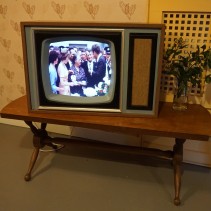
Ulysses, published in 1922 and considered to be one of the most important books ever written, is 265,000 words in 18 episodes. This blog about Ireland, now on Part 4, will never win any literary awards – but will hopefully keep your attention until I finish recapping the details of our extraordinary romp around Ireland! There’s so many great experiences to share! (And I’ll try to keep it under 200,000 words!)
At last report, we’d settled in to our luxurious digs at the gorgeous Mount Juliet Estate in County Kilkenny in southeast Ireland.
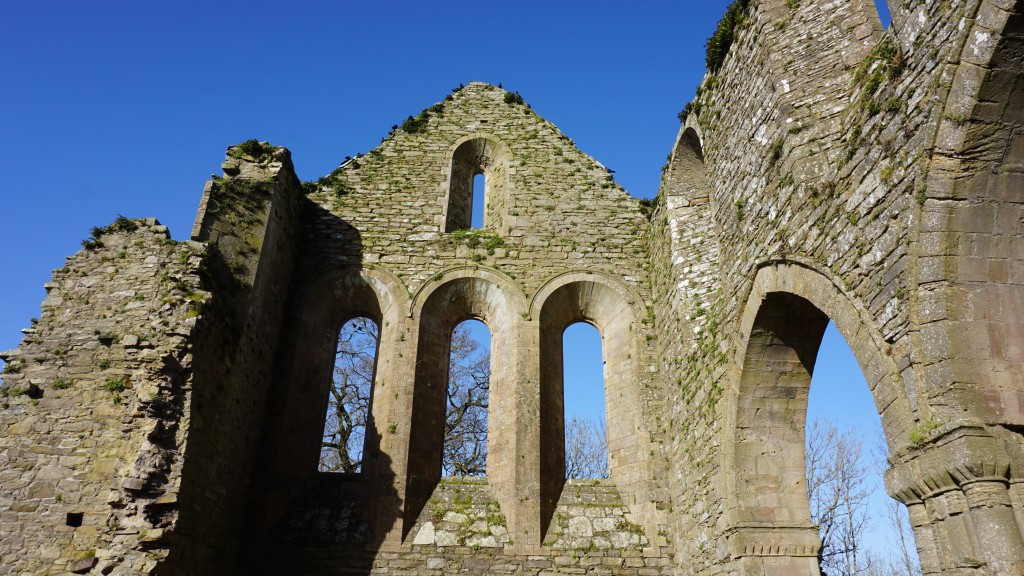
The beautiful ruins of Jerpoint Abbey, built in 1180 for the Cistercian monks.
Throughout the week, we’d already heard many facts about the history in Ireland – much of which is irrelevant to Americans. But on Day 6, we were to have two specific experiences of Irish history that had significant consequences for the United States.
We first visited the Kennedy Family Homestead in Dunganstown, in County Wexford. President John F. Kennedy was an Irish hero, and idol: the ultimate success story. His great-grandfather had come to the U.S. just three generations before.
The genealogy: Patrick Kennedy (born 1823) was the youngest of three sons. His elder brother, John, had inherited the family farm, which was too small to sustain all three sons. They had enough money to send one of the siblings to America. Which brother would go? The only fair way to decide was a coin toss. Patrick lost the toss and left Ireland, at age 26, on one of the famine ships destined for Boston in 1849.
Fast forward to June, 1963, when the most famous and powerful man in the world – was to visit his ancestral home.
We were the only visitors there on this sunny morning. As I wandered through the original milking shed, now converted into an informal museum – I was engrossed by newsreel footage playing on an old television set. President Kennedy’s triumphant motorcade – in an open limousine – down O’Connell Street in Dublin. The following day, his helicopter lands in a pasture and he greets his cousin, Mary Ryan, with a kiss on the cheek. Her neighbors had helped prepare tea and homemade salmon sandwiches that were laid out on trestle tables in the courtyard with a banner reading, “Welcome home, Mr. President”.
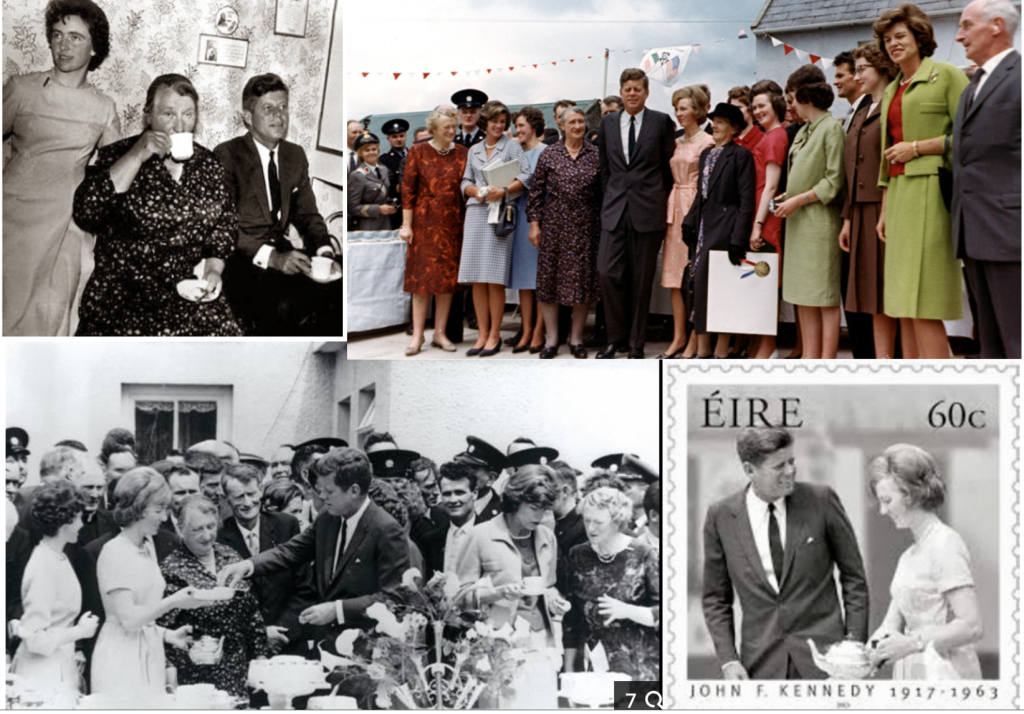
What do you serve your visiting cousin – and his entourage?
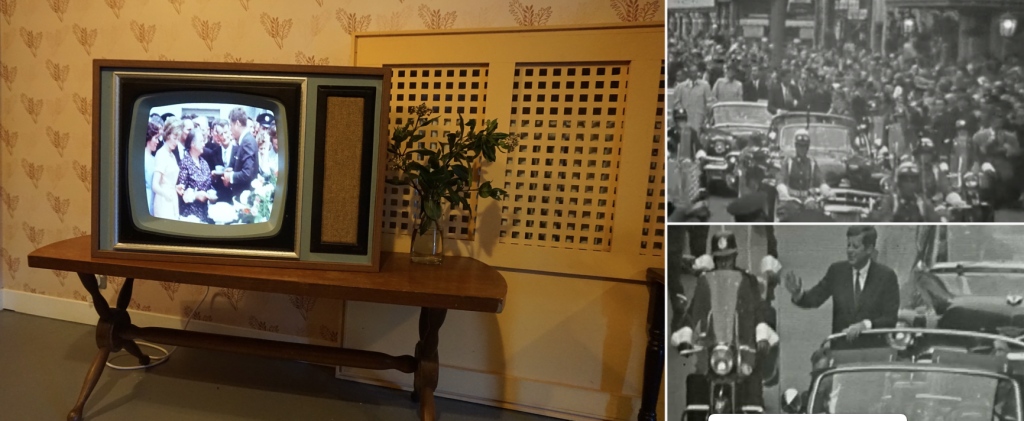
It was fascinating to watch newsreels of not-so-ancient historical events on a vintage television
He spent an hour chatting with his Irish family on that day. As he cut into a large cake, with teacup in hand he said, “I want to drink a cup of tea to all those Kennedys who went and all those Kennedys who stayed.”
There was also some amusing footage of the first televised presidential debate between Kennedy and Richard Nixon. Wow – how times have changed! And, my next thought, “What if JFK had not been killed?”
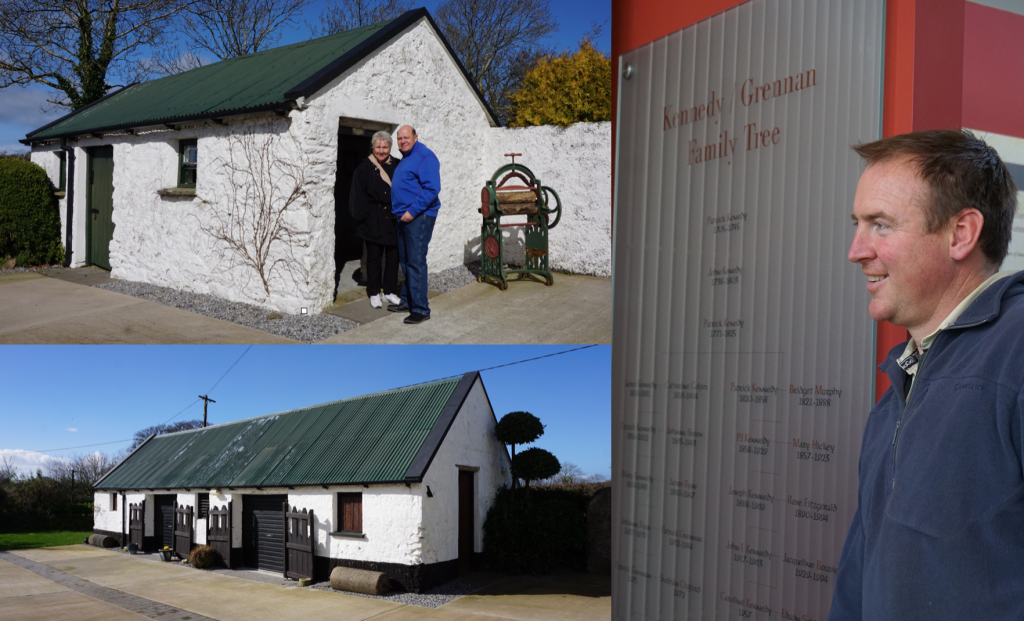
Tidy homestead buildings are well preserved; Patrick Grennan, resident farmer and curator of his family’s heritage homestead.
Just five months after his visit to Ireland, his widow, Jackie, would recall one of his favorite moments of his visit to Ireland, when a group of Irish Army cadets did a wreath-laying and silent funeral drill. And so she made a special request of the Irish government to have those cadets perform the drill at his state funeral. Passports were expedited and those young soldiers – who only months before had impressed the President of the United States with their disciplined drill routine – were now laying a wreath at his tomb at Arlington in front of foreign dignitaries from all over the world. It’s the only time foreign troops have ever rendered honors at the funeral of an American president.
As I looped back through to the visitor center with its interactive exhibits, I was deeply moved by the display of his rosary beads – which were in his pocket on that fateful day in Dallas. I had just turned nine when the announcement came over the loudspeaker in my 4th grade classroom at St. Stephen’s …
At this point, I was feeling despondent and discouraged. But my mood was brightened when we were introduced to Patrick Grennan (born 1975), the current owner of the Kennedy farm, curator of the museum and a first cousin three times removed (or was it 3rd cousin, once removed . . .?). Patrick was gracious and friendly, and told us how happy he was to have Americans visit his family’s homestead.
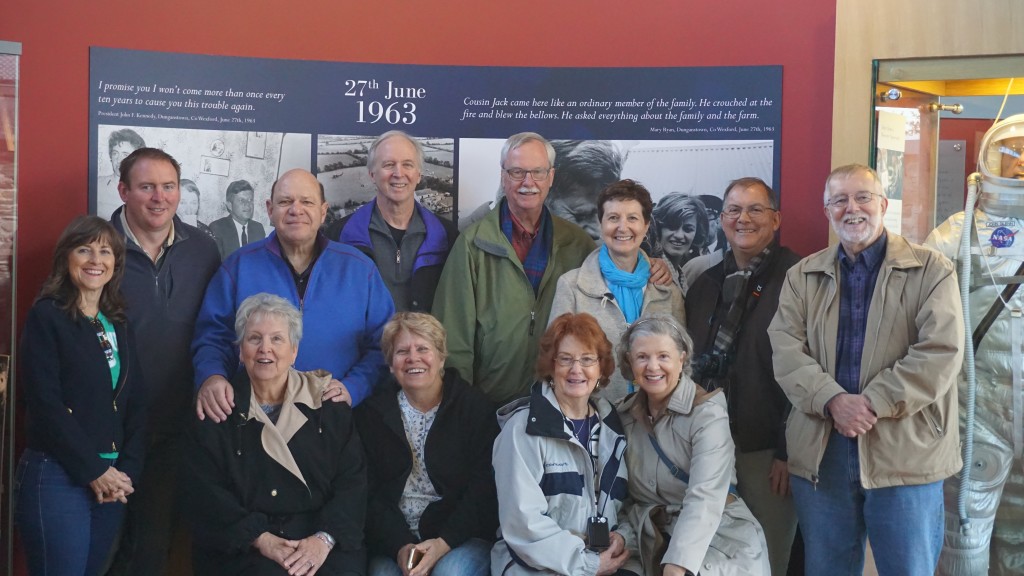
Our group (plus a wayward astronaut), posing with Patrick Brennan at the Kennedy Homestead.
In the afternoon, we went to the town of New Ross to visit the Dunbrody, an exact replica of the original three-masted ship, built in 1845, which carried thousands of Irish immigrants to a (hopefully) better life in America.
One of my cousins has done some genealogical research on our Murphy family tree, but was never able to trace us back over the Atlantic. (He was John Murphy – there couldn’t be too many of those … right?), but there’s no doubt that my Irish ancestors came to America in the mid-1800s.
Starting with an a/v presentation, we learned about the Great Famine – when a potato blight killed the staple crop of the Irish tenant farmers. This economic blow was exacerbated by the hostility and inaction of the British politicians. Despite the fact that there was plenty of food for export, within seven years, one million Irish people had died and 1.5 million had emigrated.
Then it was time to board. We each received a “Passenger Contract,” showing the total fee of £17, which covered seven family members who would share cramped quarters in steerage for the six-week trans-Atlantic crossing. We were to bring our own bedding and utensils. The ship would provide 3 quarts of water per day for each adult plus a small quantity of biscuits, flour and potatoes.
A costumed guide provided commentary about the experience onboard: Packed below decks, steerage passengers barely saw the light of day, as small groups were allowed up on deck for no more than one hour a day where they would gather around open stoves to cook. Then it was back down into the dark, damp, dreary hold. During the frequent storms, hatches were battened down and passengers had to subsist on hard-tack biscuits.
Using buckets for toilets and only seawater for washing, disease was rampant. Cholera and Typhus accounted for a great many deaths – as many as 50% of the passengers on these ships never made it and were buried at sea. No wonder they became known as ‘Coffin Ships’.
After weeks cooped up in these terrible conditions, Irish emigrants arrived in North America. Many were filthy, penniless, and often illiterate; making their subsequent success all the more remarkable.
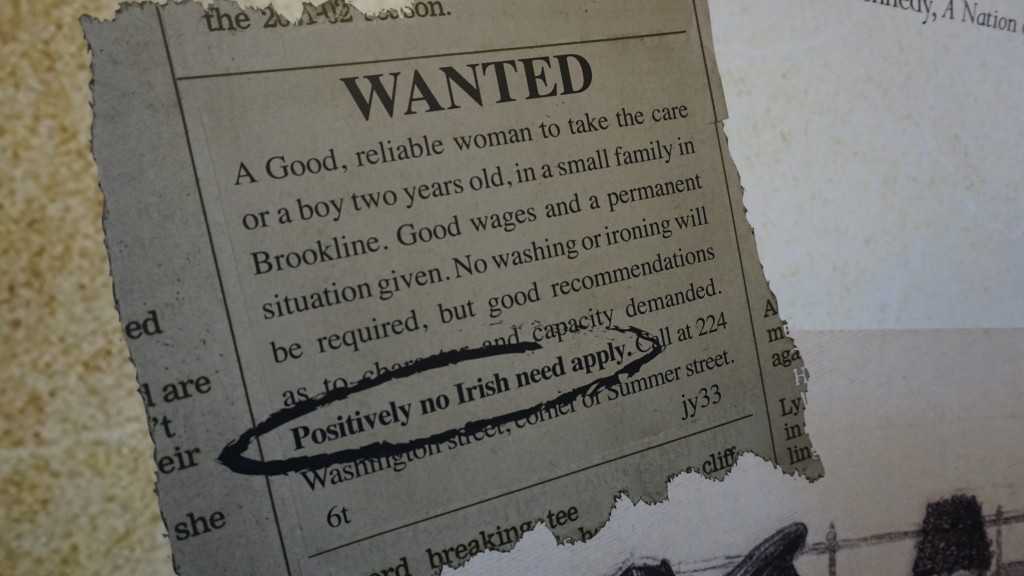
After a treacherous 6-week crossing, Irish immigrants were told that they “need not apply” . . .
That evening, we enjoyed one of the most delightful experiences of our journey. We divided into smaller groups of six and five, and traveled to a private home where we were warmly welcomed by our Irish hosts. My small group dined at the home of Richenda Talbot and her husband, Michael, as well as two other couples they’d invited for the experience. We enjoyed spirits and spirited conversation in the parlor of their 18th century home near Ballyragget (love the town names!). Dinner was served in the lovely dining room; a traditional (and tasty) meal of Irish beef, potatoes and organic veggies from her garden. We learned that Richenda’s ancestral property had once extended for many miles around. But no longer . . .
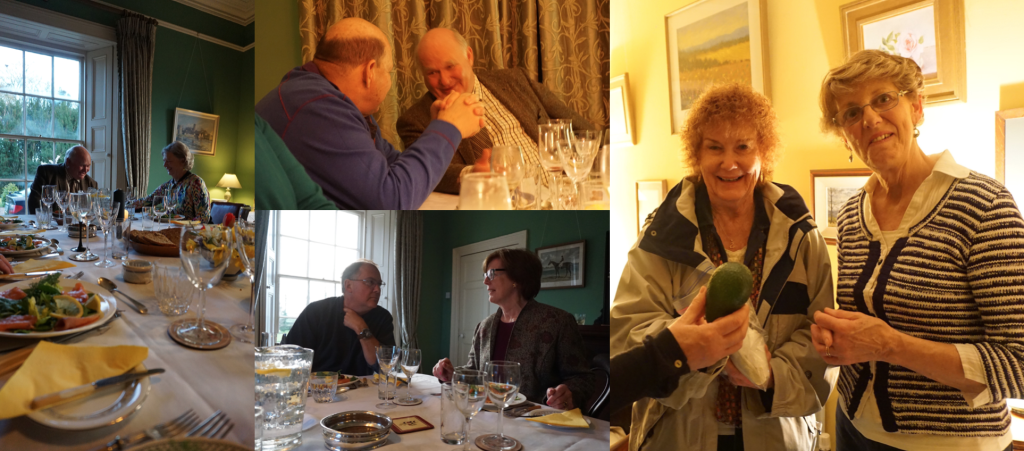
We thoroughly enjoyed the Irish hospitality. But they are deeply puzzled about one particular presidential candidate . . . for which we had no good answers.
A quote attributed to John Kennedy could have been uttered by any of us after that delightful evening, “Some of us who came on this trip feel ourselves at home and not in a strange country, but feel ourselves among neighbors, even though we are separated by generations, by time, and by thousands of miles.”
And one more thing that he said at the conclusion of his trip in 1963, “I’ll be back next spring . . .”
Please share your comments in the white box below. Thank you!
Copyright 2025 WOW! Travel. All Rights Reserved.
1 Comments
Diane LenkiN May 6, 2016 at 4:59pm
Hearing that Irish are always ready to party I am reminded of one of your endearing qualities. Irish DNA